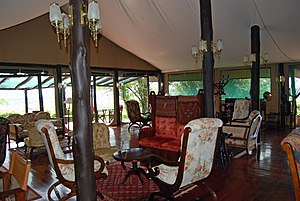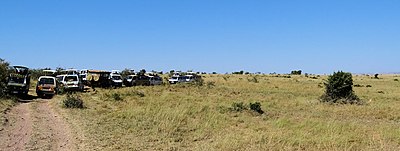For many travelers to Africa, a safari is the highlight of their trip and safaris today are one of the—if not the—greatest tourism draws in Africa. In popular use, it refers to overland travel to view the stunning African wildlife, particularly on savanna. "Primate safaris" and safaris in forests/jungle are covered in the "See/Flora & Fauna" section above. Aside from North Africa and the limited opportunities in the Sahel, most countries have at least one national park offering visitors the opportunity to go "on safari".
In colonial times, the main attraction of a safari was usually big game hunting; for most travellers today, it is instead about wildlife photography.
Understand
Safari is the Swahili word for a long journey (by any means). The safari as known to Westerners originates in an 1836-37 British expedition set out purely to observe and document wildlife and landscapes of southern Africa. This expedition set forward a style to be followed later by many other colonial-era expeditions and hunting parties in the savannas of Southern & East Africa, beginning with a minimally-strenuous rising at first light, an energetic day walking, an afternoon rest then concluding with a formal dinner and telling stories in the evening over drinks and tobacco. It is from these Victorian-era explorers that khaki clothes, pith helmets, multi-pocketed safari jackets, and leopard-print clothes and accessories have become associated with safari style.
Today, a safari can take on a range of forms, from week-long stays at a private lodge with daytrips on the savanna in search of the "Big five" to a minibus and guide hired for the day to drive backpackers through a national park to view the wildlife. Not only do the general travel styles (accommodations, transport, difficulty, etc.) cover a wide range of options, but the terrain and types of wildlife also vary greatly by region. The most common image of a safari is one in which travelers are taken by 4x4 across the savanna in search of the "Big five" that generally attract the most interest—elephants, lions, leopards, rhinos, & buffalo. Such safaris are offered primarily in Southern and East Africa, particularly Kenya, Tanzania, Zambia, Zimbabwe, Botswana, Namibia, & South Africa. Safaris in this region are big business and nearly all local governments are keen on conservation and aware that the volume of visitors generated is a boost to their economy. As a result, many parks have strict regulations both on visitor activities and behavior in the park and on the safari guides who operate in them along with modest-to-expensive entry & camping fees. Among the most well-known park to experience such safaris are South Africa's Kruger National Park, Tanzania's Ngorongoro Crater, the Okavango Delta region of Botswana, and the Tsavo East/West National Parks. Nairobi National Park on the edge of Kenya's sprawling capital is popular for its accessible location and the ever-elusive picture of cheetahs with skyscrapers in the distance.
Get around
The three basic safari styles are driving safari, walking safaris, & mobile safaris. In some regions, possible options include safaris on boats/canoes (similar to driving safaris) or riding on horses or elephants (similar to walking safaris). Some operators offer aerial trips over parks on hot air balloon or light aircraft which are marketed as "safaris", offering breath-taking views of the environment, but aren't as good for wildlife viewing as traditional safaris (except for the rare glimpse of large herds of animals. A "fly-in safari" is the term used for any of these types of safari where the visitor is flown directly (or very close) to a lodge on light aircraft, rather than arrive at an international airport and driving hours overland to the lodge. The driving safari is by far the most popular form of safari and is best for most first-timers as it is easier, often cheaper, and generally allows you to see more wildlife. A driving safari can be a one-day affair, but it often includes a couple nights spent camping (for low budgets) or in lodges within the park. Low-price driving safaris are often made in minibuses without a guaranteed window seat. Luxury safaris on a large budget will likely include drives in a 4x4 Land Cruiser or Land Rover with only a handful of others and stays at fine lodges with swimming pools, spas, private balconies, and numerous other quality amenities. A walking safari (also called a "bush walk", "hiking safari", or going "footing") consists of hiking, either for a few hours or several days. These safaris don't permit viewing as many animals as when driving, but allows a much more intimate experience. Hiking, safari goers will be able to get closer to some animals (not too close, as most are dangerous) and have experiences like stumbling upon the bones of a recent lion kill. Mobile safaris are the ultimate in luxury. Harkening back to the colonial era, a mobile safari is where an entire camp or lodge is set up each night of your safari. Waking up in the morning, you will leave by 4x4 or foot to explore the park, a small camp with meals already prepared is set up for lunch, and after more sightseeing, you arrive at a luxurious camp of spacious living, dining, and sleeping tents outfitted with comfortable chairs, beds, and accessories. These camps are moved during the day by an team of staff you likely won't encounter and ready for your arrival at the next location each night.
Cost

- For the most basic trips of groups packed in a minivan and camping overnight, travelers should have a minimum budget of US$70/day, while some of the most visited parks may cost US$100–150/day for such a trip. For luxury trips consisting of flying into a lodge for a week with guided, personal 4x4 trips onto the savanna with an assurance of seeing every animal desired can easily run over US$1000/day. If a tour operator offers you a package at a price that seems too good to be true, it often is, and there is probably a good reason why (unless it's an outright lie) someone might be offering a significantly lower price than a dozen other operators for the same park. This can be the result of hidden fees (arriving at the park, when the operator tells you to pay your US$50 entrance fee or camping permit...it wasn't covered), large errors/omissions/lies when calculating a price, an unlicensed operator, abusive labor practices (paying inexperienced porters exceptionally low wages compared with other operators), poor equipment (riding a 30 year old minibus in disrepair), length of the trip (a "daytrip" may be a quick 4 hr drive, not a slow journey from dawn-dusk), and extras that you may not have thought of or which this operator plans to charge a steep fee (not providing food, water, sunscreen, & insect repellant...but offering snacks for a fee). Make sure to thoroughly check what each tour operator provides in their cost and make sure it gets put in writing before payment and the start of the safari! You may also want to ask fellow travelers in hotels, hostels, or restaurants for their experiences with local safari operators.
- Self-drive safaris are possible in some parks, but highly discouraged for first-time safari goers. For some parks, part of licensing tour guides is education on the local wildlife & environment, which independent safari goers will miss out on, and a good guide will know the best times & places to glimpse wildlife, which is largely lost on independent safaris. Most parks have placed restrictions on the behavior of visitors for both conservation purposes and your safety, especially, which may be difficult for novices to follow when unaccompanied. Roads are often rough and sometimes difficult to navigate without offroad driving experience. Not only that, but most rental car agencies will not rent vehicles without a driver or for off-road use. Independent drivers will also want an HF radio to communicate with park rangers & others for safety reasons and should not exit their vehicle without a firearm—obviously those lions & leopards bringing down massive wildebeest and zebras will have easy pickings preying on you! The relatively high entrance fees for most parks (and, if applicable, vehicle rental) often narrows the difference in cost between an independent driving safari and going with a licensed operator to the point that the latter is a good value.

- Bear in mind that most wildlife parks and reserves are large, with some animals elusive and/or nocturnal. For this reason, booking a longer safari allows you to see more of what you want to see. One-day safaris are often touted in small towns near major parks. However, a part of your trip will be spent between orientation and simply driving to/from the park and 8 hours and US$100 later, you may be disappointed in only seeing a couple of the big five from a long distance away. Most people will want to spend at least 3 days (2 nights) on safari, allowing time to slowly drive through areas rich in animal life, wait patiently in spots for animals to pass by, drive close to groups of animals, and maybe even venture out at night to view lions on the hunt or the nocturnal & elusive leopard.
- Some people believe it is more ethical to only support locals (ie.African owned/operated tour operators) as part of a sustainable or ethical/responsible travel ideology. There are pros and cons to practicing this when trying to book a safari and the ultimate choice is left to the individual. There are many quality safari operators owned, run, & staffed by locals who provide a good product liked by their clients. However, for every quality local safari operator, there are 1-2 operators who are dishonest (with fees & promises), offer poor service (broken promises, lack of good equipment like tents, use very old/unsafe vehicles), operate unlicensed, don't offer proper equipment (no firearms when leaving vehicle, use poorly maintained vehicles), or circumvent laws (not acquire proper permits or respect conservation laws), while some con-artists will approach travelers as safari operators and seem convincing only to disappear after receiving payment or after a small part of the promised safari has been provided. On the other hand, there are many non-native safari operators who have lived in Africa for a considerable portion of their lives and are keen on conservation, pay local staff better than African-owned safari operators, work with locals in nearby communities to supply fresh fruits or veggies, and are more knowledgeable both with the local environment and Western culture (more relatable in conversation, more fluent in English). Ecotourism and establishments practicing responsible tourism are increasingly common in sub-Saharan Africa and with higher cost of running such establishments (lodges, tour operators), many are not owned/operated by locals, yet nonetheless operate to ethical standards. In short, the merits of responsible travel are noble, but when discerning which safari operator to chose, the answer is not black-and-white (pardon the pun), with a wide number of factors to consider and the ultimate choice being left to the traveler.
